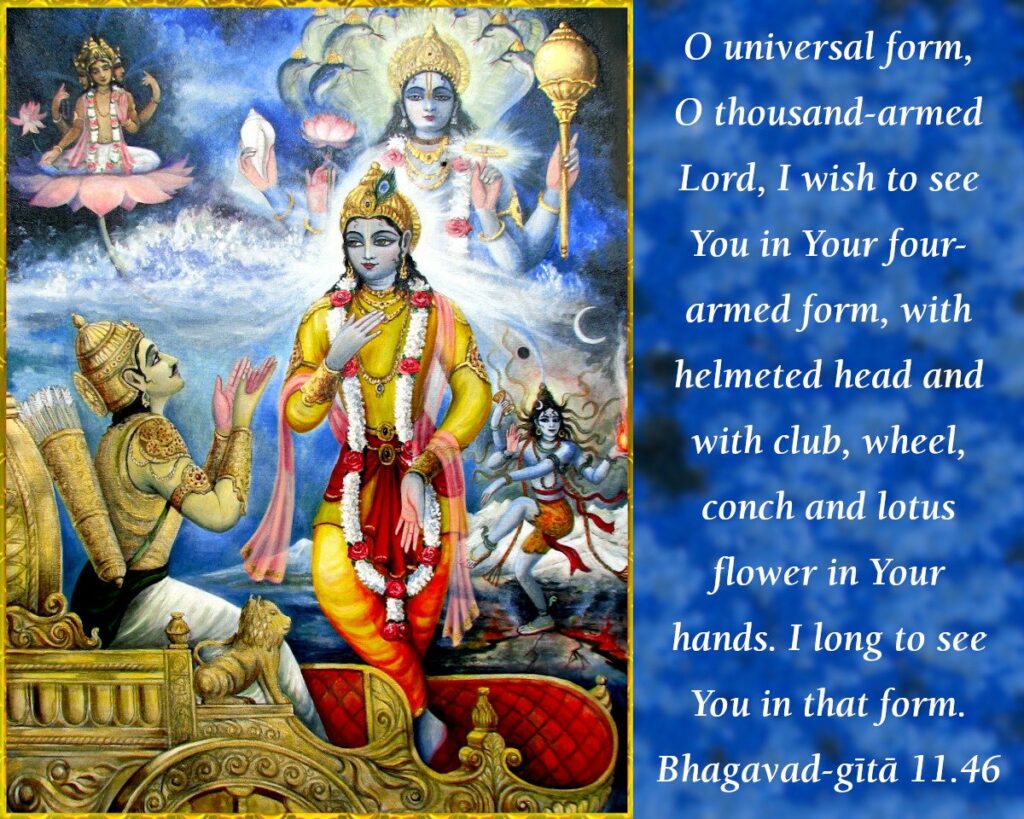किरीटिनं गदिनं चक्रहस्त-
मिच्छामि त्वां द्रष्टुमहं तथैव |
तेनैव रूपेण चतुर्भुजेन
सहस्रबाहो भव विश्वमूर्ते || 46||
kirīṭinaṁ gadinaṁ chakra-hastam
ichchhāmi tvāṁ draṣhṭum ahaṁ tathaiva
tenaiva rūpeṇa chatur-bhujena
sahasra-bāho bhava viśhva-mūrte
kirīṭinam—wearing the crown; gadinam—carrying the mace; chakra-hastam—disc in hand; ichchhāmi—I wish; tvām—you; draṣhṭum—to see; aham—I; tathā eva—similarly; tena eva—in that; rūpeṇa—form; chatuḥ-bhujena—four-armed; sahasra-bāho—thousand-armed one; bhava—be; viśhwa-mūrte—universal form
Translation:
O Thousand-armed One, though You are the embodiment of all creation, I wish to see You in Your four-armed form, carrying the mace and disc, and wearing the crown.
Commentary:
A question arises in this verse. When Arjuna says, “tenaiva rupena chaturbhujena,” it is implied that he has seen this delightful form before? If so, when did he see this form? It appears from his imploring the Lord to forgive him for any word or act of disrespect to Him, that he has not formerly realised the Divinity of the Lord, but regarded him as a friend and relation. This contradiction can be reconciled in the following way.
(1) Before the Lord revealed His Cosmic-Form, He should have shown the four-armed form of Vishnu. In the 50th verse, it is said that the Lord appeared again in His normal form, (bhuyah svakam rupam darsyamasa), and also that the Lord appeared in His gentle form (punah saumyavapur mahatma). Thus we come to know that the Lord had shown the four-armed form of Vishnu just before he assumed the Visvarupa.
(2) Arjuna might have heard that when the Lord was born to Devaki, He appeared in the form of Vishnu with Discus, Conch and Crown etc.
3) By seeing the Cosmic-Form, Arjuna realises that he is no other than the Supreme Lord Vishnu who rules Viakunta in His delightful form.
Bhagavad Gita: Chapter 11 🔻 (55 Verses)
| 01 | 02 | 03 | 04 | 05 | 06 | 07 | 08 | 09 | 10 |
| 11 | 12 | 13 | 14 | 15 | 16 | 17 | 18 | 19 | 20 |
| 21 | 22 | 23 | 24 | 25 | 26 | 27 | 28 | 29 | 30 |
| 31 | 32 | 33 | 34 | 35 | 36 | 37 | 38 | 39 | 40 |
| 41 | 42 | 43 | 44 | 45 | 46 | 47 | 48 | 49 | 50 |
| 51 | 52 | 53 | 54 | 55 |
